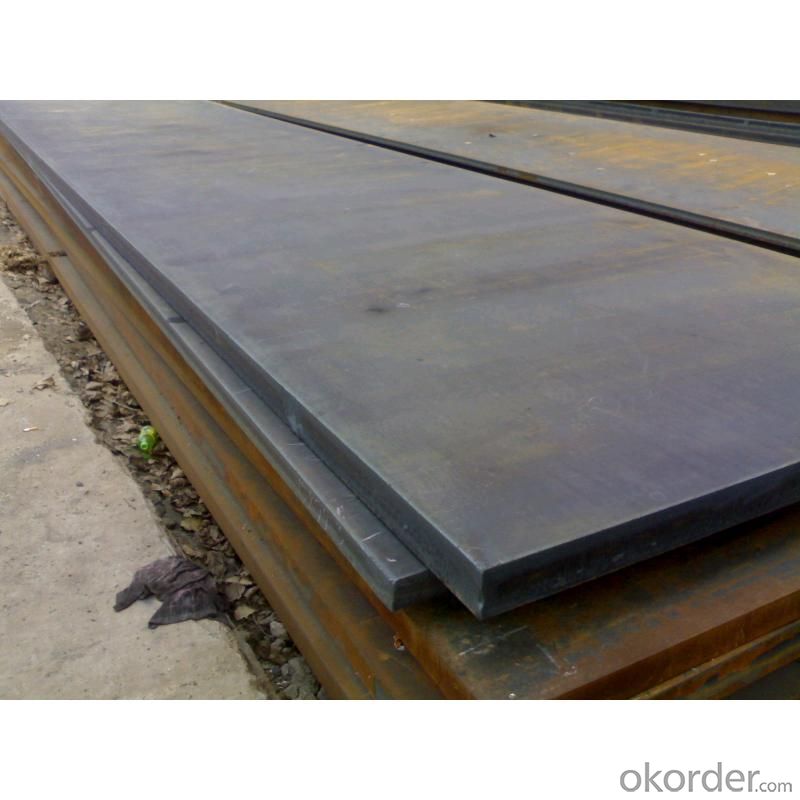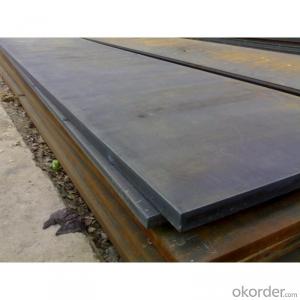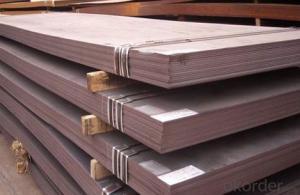Hot Rolled Steel Plate for Shipbuilding Pipeling Good Quality
- Loading Port:
- China main port
- Payment Terms:
- TT OR LC
- Min Order Qty:
- 1000 m.t.
- Supply Capability:
- 10000 m.t./month
OKorder Service Pledge
Quality Product, Order Online Tracking, Timely Delivery
OKorder Financial Service
Credit Rating, Credit Services, Credit Purchasing
You Might Also Like
Structure of Hot Rolled Steel Plate Description
JIS G3131 SPHC\ASTM A569 for shipbuilding and pipeline
Main Features of the Hot Rolled Steel Plate
Hot rolled with good quality
Images Hot Rolled Steel Plate


Specification Hot Rolled Steel Plate
Standard: JIS G3131 SPHC\ASTM A569
Thickness: 0.17mm-1.0mm
Place of Origin: Shandong China (Mainland)
Type: Steel sheet
Application:Building
Width:600-1250mm
Length: as your respect
FAQ of Hot Rolled Steel Plate
Quality Insurance
- Q:Are the steel sheets resistant to atmospheric corrosion?
- Yes, steel sheets are typically resistant to atmospheric corrosion due to their protective oxide layer which acts as a barrier against rust and other forms of corrosion caused by exposure to air and moisture.
- Q:The differences and uses of cold rolling and hot rolling
- The free torsion rigidity of hot rolled steel is higher than that of cold rolled steel, so the torsion resistance of hot rolled steel is better than that of cold rolled steel
- Q:Are steel sheets suitable for manufacturing HVAC grilles?
- Yes, steel sheets are suitable for manufacturing HVAC grilles. Steel sheets offer durability, strength, and corrosion resistance, making them an ideal material for HVAC grilles that need to withstand various environmental conditions. Additionally, steel sheets can be easily shaped and customized to meet specific design requirements, ensuring proper airflow and efficient functioning of the HVAC system.
- Q:Are steel sheets resistant to UV rays?
- Steel sheets do not possess inherent resistance to UV rays, contrary to belief. UV damage can indeed affect steel, leading to fading, discoloration, or even corrosion with the passage of time. However, the degree of harm incurred is contingent upon several factors, including the steel type, sheet thickness, UV exposure specifics, and presence of protective coatings. In order to bolster the UV resistance of steel sheets, manufacturers commonly administer coatings like paint, powder coatings, or galvanized finishes, which offer some level of defense against UV rays. It is vital to consult steel suppliers or manufacturers to ascertain the precise UV resistance capabilities of the steel sheets in use and consider supplementary protective measures if deemed necessary.
- Q:Can steel sheets be used for electrical applications?
- Yes, steel sheets can be used for electrical applications. While steel is not a good conductor of electricity, it can be used as a protective casing or enclosure for electrical components or as a structural support in electrical systems.
- Q:What is the maximum thickness of steel sheets?
- The maximum thickness of steel sheets can vary depending on various factors such as the type of steel being used, the manufacturing process, and the intended application. Generally, steel sheets can range from a few millimeters to several centimeters in thickness. However, for most common applications, the maximum thickness of steel sheets typically falls within the range of 20-30 millimeters. It is essential to consider the specific requirements and specifications of the project or application to determine the appropriate thickness of steel sheets needed.
- Q:What are the different coating options available for steel sheets?
- Steel sheets can be coated in various ways, each offering unique benefits and protection against different environmental factors. Some commonly used coatings include: 1. Galvanized Coating: The most widely used coating involves applying a layer of zinc to the surface. This acts as a sacrificial anode, preventing corrosion. Galvanized coating provides excellent corrosion resistance and works well for both indoor and outdoor applications. 2. Galvannealed Coating: Similar to galvanized coating, but further heat-treated to form a zinc-iron alloy layer. This coating improves paint adhesion and weldability, making it suitable for applications that require painting or additional fabrication processes. 3. Electroplated Coating: This process immerses the steel sheet in a solution containing metal ions and applies an electric current to deposit a thin layer of metal onto the surface. Common electroplated coatings include zinc, nickel, and chromium. They enhance corrosion resistance and aesthetics. 4. Organic Coating: Also known as painted or coated steel sheets, this option involves applying an organic material layer like paint, powder coating, or plastic film. Organic coatings protect against corrosion, UV radiation, and abrasion. They offer a wide range of colors and finishes, making them suitable for architectural and decorative applications. 5. Tin Coating: Tin-plated steel sheets have a thin layer of tin applied through an electroplating process. Tin coating provides excellent solderability, corrosion resistance, and food-grade suitability. It is commonly used in food cans and packaging materials. 6. Aluminized Coating: This coating applies a layer of aluminum to the steel surface through a hot-dipping process. Aluminized coating provides excellent heat reflectivity, corrosion resistance, and thermal conductivity. It is often used in heat-resistant applications like exhaust systems and heat exchangers. These are just a few of the many options available for coating steel sheets. The choice depends on factors such as intended use, environmental conditions, and desired properties. It is crucial to consider these factors and consult with coating experts to determine the most suitable option for specific applications.
- Q:Are the steel sheets heat-resistant?
- Yes, steel sheets are heat-resistant.
- Q:What is the minimum thickness of steel sheets?
- The minimum thickness of steel sheets can vary depending on the specific application and industry standards. However, typically, steel sheets are available in thicknesses ranging from 0.4mm to 6mm.
- Q:Can the steel sheets be cut easily?
- With the correct tools and techniques, steel sheets can be easily cut. Despite its strength and durability, steel can still be cut through methods like shearing, sawing, or by utilizing plasma or laser cutting machines. The ease of cutting steel sheets is influenced by factors such as thickness and the particular type of steel employed. Generally, thinner sheets are more manageable to cut compared to thicker ones. Moreover, employing suitable cutting tools and adhering to safety precautions will guarantee a seamless and effective cutting process.
1. Manufacturer Overview |
|
|---|---|
| Location | |
| Year Established | |
| Annual Output Value | |
| Main Markets | |
| Company Certifications | |
2. Manufacturer Certificates |
|
|---|---|
| a) Certification Name | |
| Range | |
| Reference | |
| Validity Period | |
3. Manufacturer Capability |
|
|---|---|
| a)Trade Capacity | |
| Nearest Port | |
| Export Percentage | |
| No.of Employees in Trade Department | |
| Language Spoken: | |
| b)Factory Information | |
| Factory Size: | |
| No. of Production Lines | |
| Contract Manufacturing | |
| Product Price Range | |
Send your message to us
Hot Rolled Steel Plate for Shipbuilding Pipeling Good Quality
- Loading Port:
- China main port
- Payment Terms:
- TT OR LC
- Min Order Qty:
- 1000 m.t.
- Supply Capability:
- 10000 m.t./month
OKorder Service Pledge
Quality Product, Order Online Tracking, Timely Delivery
OKorder Financial Service
Credit Rating, Credit Services, Credit Purchasing
Similar products
New products
Hot products
Related keywords





























